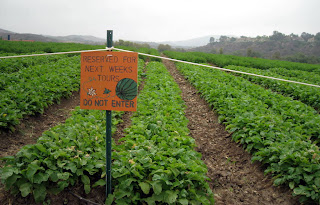One of the main reasons to join a CSA is to get to know your food supply. When you visit your food, you learn how it is grown and by whom. A small organic farm is fundamentally different than the highly-automated large-scale monoculture (single crop) farms where most conventionally grown food originate. TF, like many small farms, is messy. You will see weeds and volunteers (veggies from the last crop) everywhere.
Tanaka Farms (TF) holds several CSA Family days a year--usually in the Spring, Fall and Christmas. Strawberries and the green veggies star in the Spring visit. Kids pick and wash their own veggies. Then the Tanaka Farms staff grill them up so you can eat them for lunch right there. Afterwards, everyone is sent out to the strawberry patch to pick dessert.
When things wind down in the fall, TF tours focus on the pumpkins and the corn maize. Each December, TF also holds a Christmas party for CSA members where they also sell Christmas trees for another local farmer.
I took these pictures at the September 2010 Fall tour. See the broad-leaved weeds amid the corn? These are definitely not
Roundup Ready corn--corn that has been genetically engineered to withstand direct spraying of the glyphosate-based herbicide sold by Monsanto as Roundup. In fact, genetically-modified crops cannot be sold as organic under current labeling laws.

Do you see the insect holes on the radish greens below? Some people are turned off from organic food because it is typical to see moderate amounts of insect damage. You can see the insect holes, but you can't see the insecticides that are sprayed on conventional produce to make them look so perfect. Common
organophosphate insecticides have been linked to ADHD in children, particularly genetically susceptible children and/or children who were exposed in-utero. Other insecticides,
endosulfan and dicofol, were linked with autism.

Instead of spraying herbicides, they pull the weeds by hand. Sometimes, they get behind and the vegetable beds look a bit messy. If you visit the farm and see a weed, give them a hand and pull it out.
This is Farmer Tanaka, aka Glenn Tanaka. He learned to farm from his father. His son, Kenny, works with him along with a cadre of farm staff that has worked with the family for decades. They are all family.

Glenn says that he sprays
Neem tree oil instead of insecticides to repel insects. The oil doesn't kill the insects; insects simply don't like the taste (or smell) of the oil and stay away. Neem tree oil is very expensive compared to synthetic (but toxic) insecticides. Moreover, neem tree oil needs to be resprayed every two weeks in order to repel subsequent waves of insects. This is why organic food costs more than conventional food.
It's expensive to grow food that doesn't contain stuff that is invisible to the naked eye.
Get to know your farmer. Get to know your food. Bon appetit!
 Like the flyer says, RSVP to your school CSA coordinator if you would like to attend. It's free for all regular CSA subscribers.
Like the flyer says, RSVP to your school CSA coordinator if you would like to attend. It's free for all regular CSA subscribers.